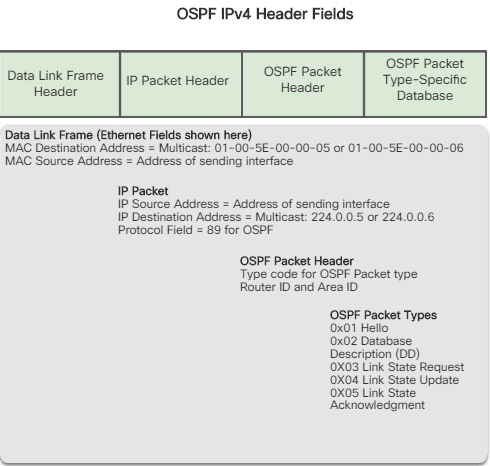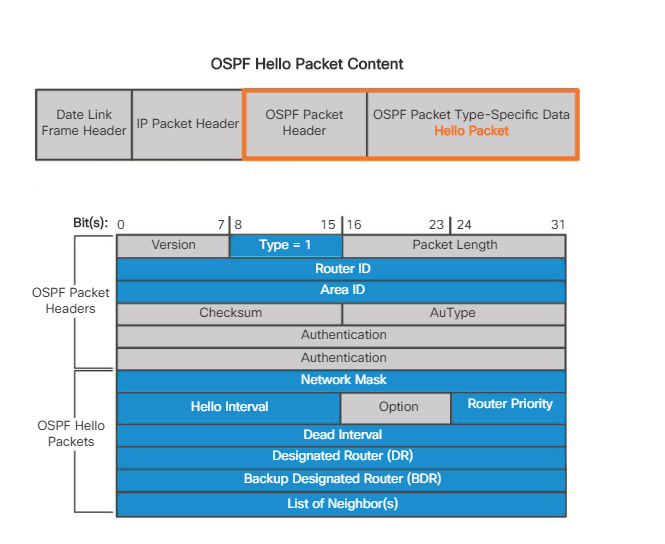1.路由协议的分类
这里的距离矢量协议指其按照度量值来决定路径,eigrp为一个高级的距离矢量协议
2.路由协议的组成
3.更新的地址
ripv2:224.0.0.9 eigrp:224.0.0.10
ripv1为有类路由协议
4.输入no auto summary为关闭主类的汇总,http://blog.51cto.com/zcry21cn/1740894
5.passive interface命令
Use the passive-interface router configuration command to prevent the transmission of routing updates through a router interface, but still allow that network to be advertised to other routers. The command stops routing updates out the specified interface. However, the network that the specified interface belongs to is still advertised in routing updates that are sent out other interfaces.
6.无论何时,当使用redistribute或default-information路由器配置命令来重新分配路径到OSPF路由选择域时,Cisco IOS软件就自动变成一个自治系统边界路由器(ASBR)。但是,一个ASBR不能缺省地产生一个缺省路径进入OSPF路由选择域。该软件在产生一个路径之前,仍必须有缺省路径,除非已说明always关键字。
7.OSPF的头部域
- Data Link Ethernet Frame Header - Identifies the destination multicast MAC addresses 01-00-5E-00-00-05 or 01-00-5E-00-00-06. (Figure 1)
- IP Packet Header - Identifies the IPv4 protocol field 89 which indicates that this is an OSPF packet. It also identifies one of two OSPF multicast addresses, 224.0.0.5 or 224.0.0.6. (Figure 2)
- OSPF Packet Header - Identifies the OSPF packet type, the router ID and the area ID. (Figure 3)
- OSPF Packet Type Specific Data - Contains the OSPF packet type information. The content differs depending on the packet type. In this case, it is an IPv4 Header. (Figure 4)
- 8.ospf报文的描述
-
- Type 1: Hello packet - Used to establish and maintain adjacency with other OSPF routers.
- Type 2: Database Description (DBD) packet - Contains an abbreviated list of the sending router’s LSDB and is used by receiving routers to check against the local LSDB. The LSDB must be identical on all link-state routers within an area to construct an accurate SPF tree.
- Type 3: Link-State Request (LSR) packet - Receiving routers can then request more information about any entry in the DBD by sending an LSR.
- Type 4: Link-State Update (LSU) packet - Used to reply to LSRs and to announce new information. LSUs contain seven different types of LSAs.
- Type 5: Link-State Acknowledgment (LSAck) packet - When an LSU is received, the router sends an LSAck to confirm receipt of the LSU. The LSAck data field is empty.
- 9.ospf的hello包中的成分
- 10.
Hello Packet Intervals
As shown in the figure, OSPF Hello packets are transmitted to multicast address 224.0.0.5 in IPv4 and FF02::5 in IPv6 (all OSPF routers) every:
- 10 seconds (default on multiaccess and point-to-point networks)
- 30 seconds (default on nonbroadcast multiaccess [NBMA] networks; for example, Frame Relay)
The Dead interval is the period that the router waits to receive a Hello packet before declaring the neighbor down. If the Dead interval expires before the routers receive a Hello packet, OSPF removes that neighbor from its LSDB. The router floods the LSDB with information about the down neighbor out all OSPF-enabled interfaces.
Cisco uses a default of 4 times the Hello interval:
- 40 seconds (default on multiaccess and point-to-point networks)
- 120 seconds (default on NBMA networks; for example, Frame Relay)




